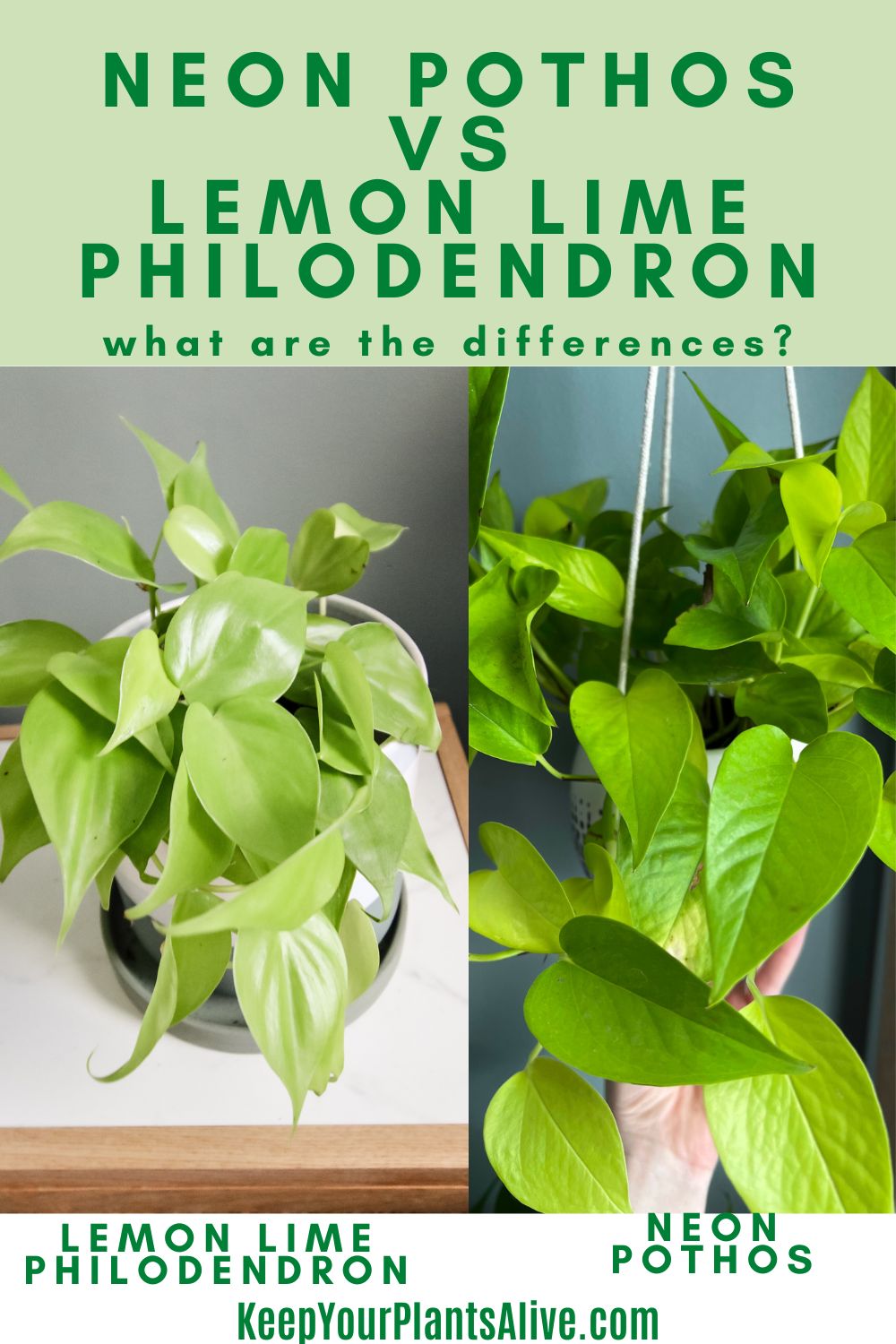Want to add a beautiful neon plant to your collection? Here is our complete lemon lime philodendron care guide!
One of my favorite houseplants is my neon pothos. I love it because it has a slightly different shade of green leaves - neon!
I was recently browsing plants on Etsy (as you do) and noticed another neon plant!
It was intriguing and oops it ended up in my cart. And I am so very happy with it in my plant collection!
Want to add a beautiful and easy-to-care-for plant to your houseplant collection? Look no further than the Lemon Lime Philodendron!
In this complete care guide, we'll walk you through everything you need to know to keep your Lemon Lime Philodendron thriving.
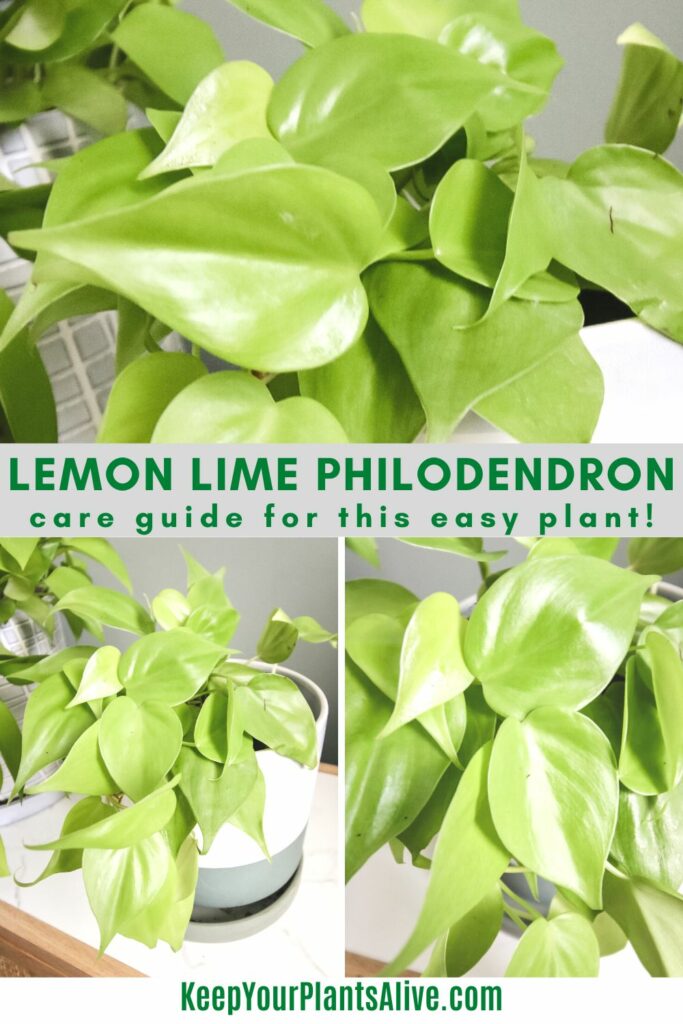
What is Lemon Lime Philodendron?
The Lemon Lime Philodendron, scientifically known as Philodendron hederaceum 'Lemon Lime,' is a popular tropical houseplant known for its vibrant, heart-shaped leaves.
Its striking foliage features shades of green and chartreuse, making it a fantastic addition to any indoor space.
Other names for Lemon Lime Philodendron include:
- Neon Philodendron
- Sweetheart Plant
- Philo Lemon Lime

Lemon Lime Philodendron origins
This beautiful plant is native to the rainforests of Central and South America, where it thrives in the warm and humid environment and grows up the trunks of trees, beneath the canopy.
Is Lemon Lime Philodendron rare?
No, the Lemon Lime Philodendron is not considered rare and is widely available in nurseries and garden centers. However, I have never seen it at my Home Depot. I ended up ordering it on Etsy!
Is Lemon Lime Philodendron toxic?
Yes, the Lemon Lime Philodendron is toxic to pets and humans if ingested. Keep it out of reach of curious pets and children.
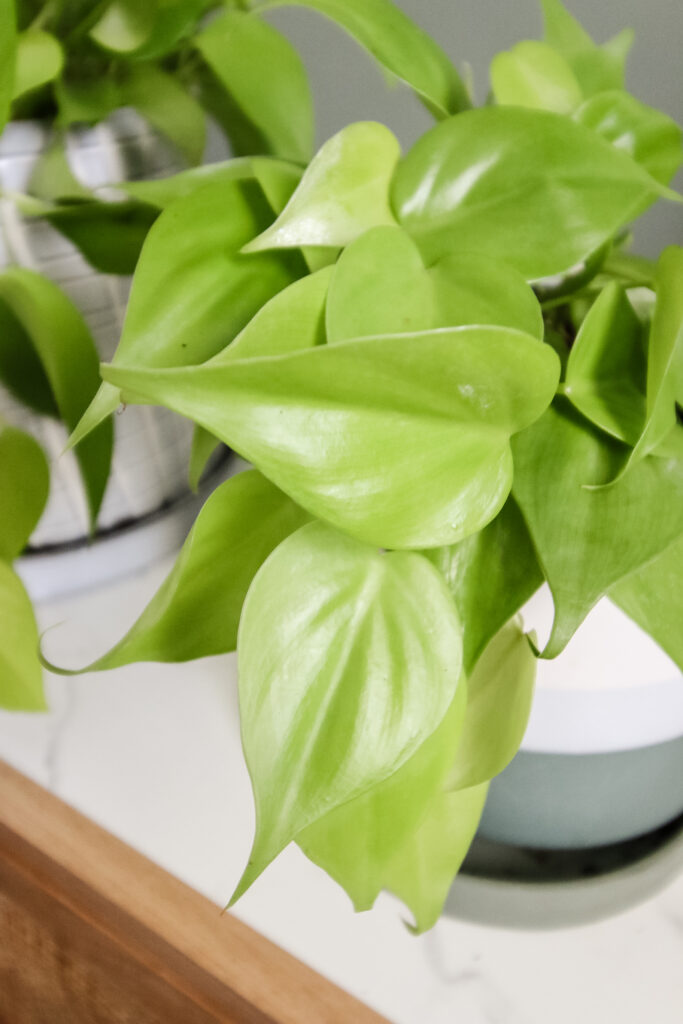
Lemon Lime Philodendron care guide
Here are the basics for keeping this easy care plant alive and thriving!
Lemon Lime Philodendron watering
The key to keeping your Lemon Lime Philodendron healthy is to maintain moderately moist soil.
Allow the top inch of soil to dry out between waterings, and then water thoroughly. This means watering until water comes out of the drainage holes.
Ensure your pot has proper drainage to prevent overwatering.
Read my guide on drilling drainage holes in pots!
How often should I water my Lemon Lime Philodendron?
Water your plant when the top 2 inches of soil feel dry to the touch, every 5-10 days.
Should I mist my Lemon Lime Philodendron?
Misting is beneficial, especially in dry indoor environments. Mist the leaves occasionally to increase humidity and prevent dust buildup.

Lemon Lime Philodendron lighting needs
The Lemon Lime Philodendron thrives in bright, indirect light. Avoid direct sunlight, which can scorch its leaves. Place it near a north or east-facing window for optimal growth.
Can I keep Lemon Lime Philodendron outdoors?
This plant is best suited for indoor conditions. While it can tolerate some outdoor exposure in a shaded or protected area, it is primarily an indoor plant.
Can lemon lime philodendron get too much sun?
Yes - the leaves of this plant are sturdy but they will burn and get crispy in too much sun. Keep them out of direct sunlight. If you notice leaves getting burnt, move them ASAP.
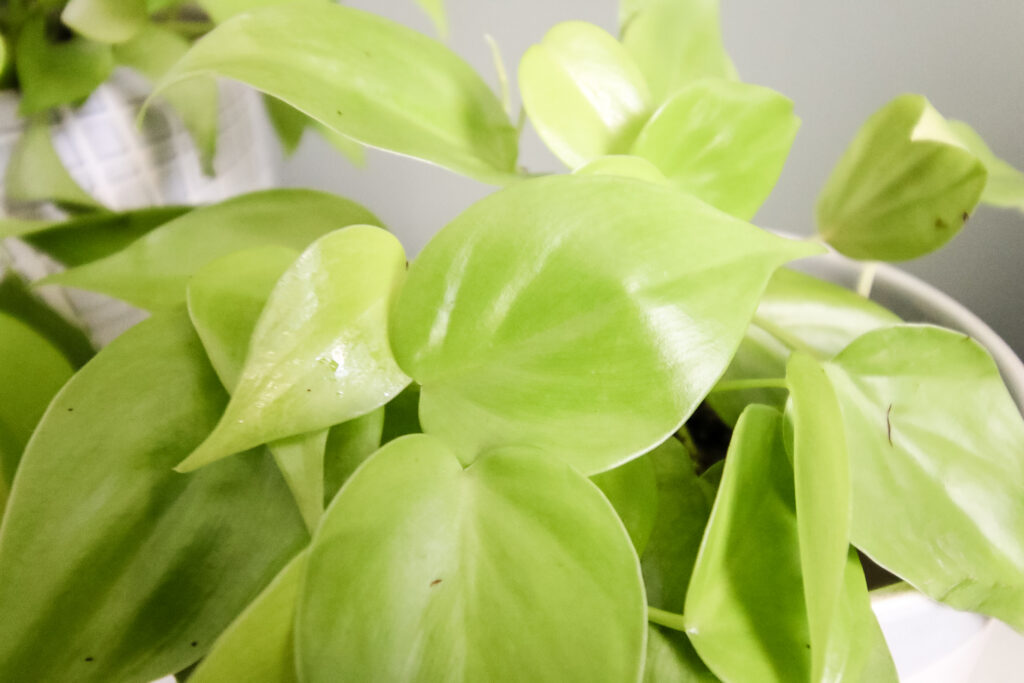
Lemon Lime Philodendron soil + potting
Here are some of the things to keep in mind when choosing soil and pots for your plant.
Does Lemon Lime Philodendron like to be root bound?
No, Lemon Lime Philodendrons prefer slightly snug pots but don't like to be severely root-bound.
Repot every 2-3 years into a slightly larger pot (1-2" larger across) to provide room for growth.
Does Lemon Lime Philodendron need a moss pole?
While not strictly necessary, providing a moss pole or trellis can encourage your Lemon Lime Philodendron to grow upright and develop larger leaves.
Here's my guide on how to make a moss pole!
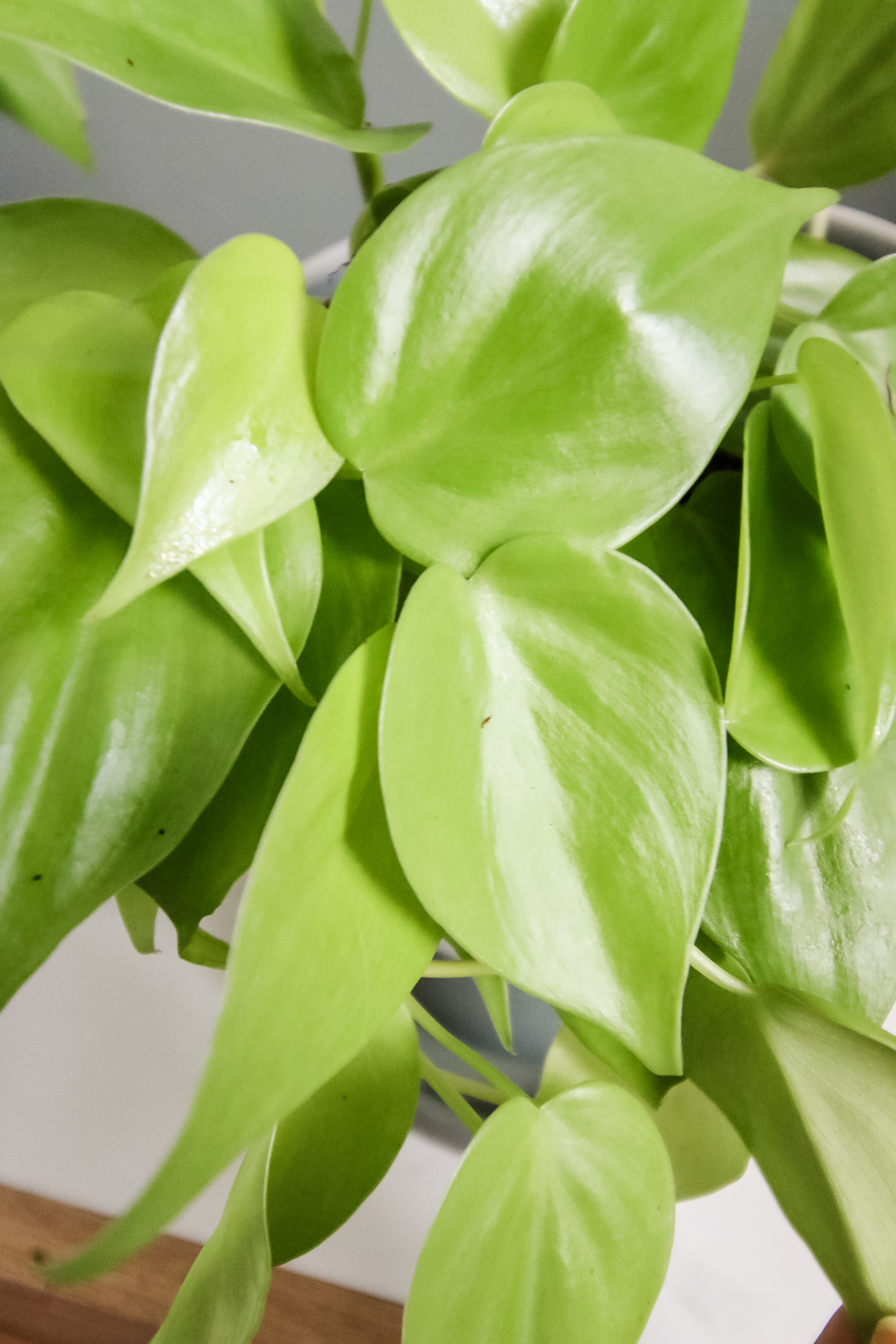
Lemon Lime Philodendron fertilization
Feed your Lemon Lime Philodendron with a balanced liquid fertilizer diluted to half-strength during the growing season (spring and summer) every 4-6 weeks.
Any basic houseplant fertilizer should work well. Just read the instructions carefully and do NOT over fertilize - it can lead to yellow leaves and leaf drop.
Skip fertilization in fall and winter.
How to propagate Lemon Lime Philodendron
It is extremely easy to propagate Philodendron in water.
- Identify a healthy branch, preferably with new growth
- Snip the branch with sharp scissors
- Remove any lower leaves
- Place in water so at least 1 - preferably 2 - nodes are underwater
- Change the water once a week and top off as necessary
- See roots form in 2-4 weeks
- Once the roots are 2-3 inches long, plant in soil

Lemon Lime Philodendron care guide
Join the (free!) KeepYourPlantsAlive+ community to access this exclusive printable plant care guide! Once you sign up, you can right click & save the JPG care guide. Or keep scrolling for more!
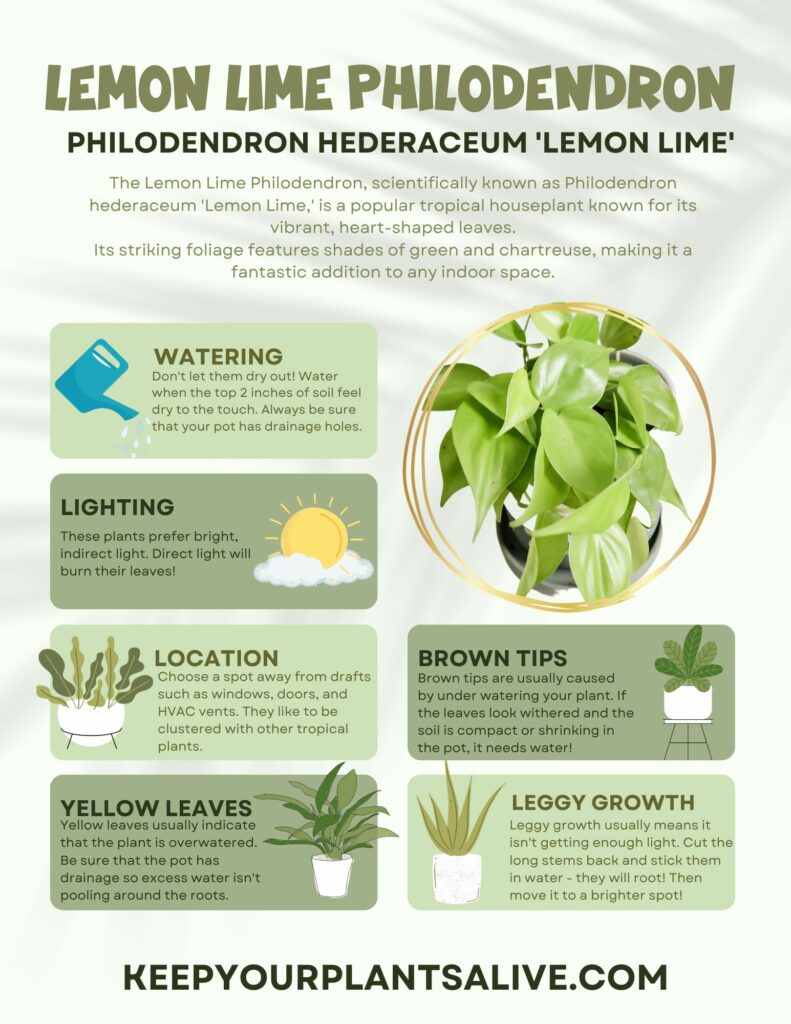
Troubleshooting Lemon Lime Philodendron
Here are some frequently asked questions about the Lemon Lime Philodendron!
Why are the leaves on my lemon lime philodendron turning yellow?
Yellowing leaves can indicate overwatering, underwatering, or poor soil drainage. Ensure you're allowing the top inch of soil to dry between waterings and that your pot has drainage holes. Check the roots for any signs of rot and adjust your watering accordingly.
Why are the leaves of my Lemon Lime Philodendron curling?
Leaf curling can be a sign of insufficient humidity or underwatering. Try misting the plant regularly and ensure you're keeping the soil consistently moist, but not waterlogged.
Can I prune my Lemon Lime Philodendron, and how should I do it?
Yes, you can prune your plant to control its size and shape. Use clean, sharp scissors or pruning shears to trim back overgrown stems just above a leaf node.
Pruning in spring or early summer is ideal for encouraging new growth.
Do I need to repot my Lemon Lime Philodendron every year?
No, you don't need to repot it annually. Repot when you notice it becoming root-bound, typically every 2-3 years.
Choose a pot that is slightly larger than the current one, and refresh the soil to provide essential nutrients.
My Lemon Lime Philodendron has brown, crispy leaf edges. What's causing this?
Brown, crispy leaf edges often indicate low humidity or exposure to dry air. Increase humidity by misting the plant, using a humidity tray, or placing a small humidifier nearby.
Ensure it's not too close to heating or cooling vents.
How can I prevent pests from infesting my Lemon Lime Philodendron?
To prevent pests like spider mites or aphids, regularly inspect your plant for signs of infestation, such as discolored or stippled leaves.
Isolate new plants for a few weeks to ensure they aren't bringing pests.
Additionally, wipe down the leaves with a damp cloth periodically to keep them clean and discourage pests from settling in. If needed, treat the plant with a gentle insecticidal soap.
Any more questions about the Lemon lime philodendron?
Thanks for reading!


Hey there, I'm Morgan, a houseplant enthusiast from sunny Charleston, South Carolina. Growing up surrounded by my mom's lush orchids and African violets, I discovered the magic of bringing nature indoors. Thanks to the pandemic, I delved deeper into houseplants, discovering their power to uplift moods and transform spaces. I'm here to spill all my secrets, helping you pick the perfect houseplant - and make it happy. Let's keep your plants alive, together! 😊

